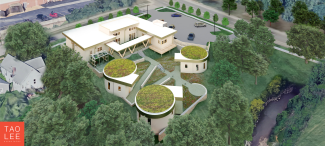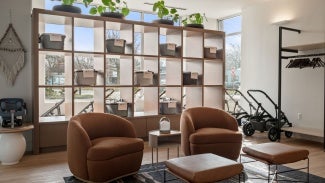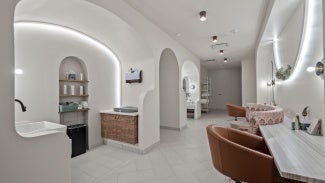
How can architects transform the birth experience in America?
Maternal death rates are staggering in the U.S. Architects see an opportunity to improve birth environments and postpartum resources for women and their families.
Despite having the world’s largest economy, the U.S. has the highest rate of maternal deaths among high-income nations, according to the Commonwealth Fund. For Black women, the maternal death rate is 2.2 times greater than the general population: 49.5 deaths per 100,000 live births versus 22.3. “Sadly, so many women, and Black women in particular, just want to survive birth,” says Kim Holden, AIA, founder of Doula X Design. “That is a really low bar.”
After delivery, mothers still face troubling odds. Nearly two out of three maternal deaths occur postpartum, up to 42 days after the birth event, while 45% of new mothers experience trauma during or after childbirth.
Because of the support she received from her midwife, doula, and family, Holden found her birth experiences to be life changing, but in a good way. More than 20 years after co-founding SHoP Architects, she left the firm to pursue a new calling. “I wanted to create a platform for greater advocacy for women and girls,” Holden says. “And I wanted to make a difference.” She became a licensed doula, consultant, and educator to help people understand what the human mind and body undergo during pregnancy.
Giving birth is often portrayed as an isolating and scary event rather than a natural, celebratory, and communal experience, Holden says. Walk into any maternity ward in America, and you will likely find what effectively are standard patient rooms with a bit more space for a bassinet, a compact sleeper chair for a partner, and additional wood trim for superficial warmth. Hospitals might call these areas “birthing centers”, she says, but “they’re birthing centers in name only.”
Holden is not alone in questioning the impact of housing one of life’s most natural experiences in institutionalized and regimented spaces for women with low-risk pregnancies. A recent study led by the University of Gothenburg, Sweden, found that birthing rooms designed to be customizable for their patients’ needs can generate lasting positive effects postpartum.
Stateside, several architects are exploring new ways design can support the transition of becoming a parent or expanding a family. In Ferguson, Mo., CannonDesign and architect-of-record Tao + Lee Associates are designing the second phase of Jamaa Birth Village, which aspires to elevate the pregnancy and birth experience, particularly for Black women. And in Ferndale, Mich., von Staden Architects has designed Fourth Tri Sanctuary, a gathering and support space for postpartum mothers.
Cultural awakening
Breaking the mold of maternal health care design can require a mindset shift for architects. “A lot of times, we automatically think that Western health care practices are ‘correct,’” says Margaret Bailey, vice president at CannonDesign and leader of the firm’s public-interest Open Hand Studio. Instead, says Gail von Staden, principal at von Staden Architects in Royal Oak, Mich., designers should be open to new ideas from multiple sources. “We spend a lot of time in our profession [establishing] ourselves as a higher ed, residential, or health care architect” to convey expertise, she says. “The flip side is that it results in a sameness.”
In the U.S., typical birth environments have women lie in a passive, “submissive” position “on your back or whatever the doctor says,” Holden says; but as mammals, humans want to “feel safe, have privacy, and be unobserved” during labor. Birth environments, she says, should give women agency to move and change their position, customize sound and lighting, and labor or deliver in a tub of warm water—anything to promote the production of oxytocin, which helps labor progress and instills calmness.
The feeling of helplessness can contribute to a negative birth experience, which “stays with you postpartum,” Holden says. Upon leaving the hospital, mothers are expected to leap into a new world while they’re physically and mentally healing. And until their first postpartum appointment, typically six weeks later, “there is no one checking on you.”
As Okunsola Amadou, a Missouri-based midwife who is CannonDesign’s visionary client for Jamaa Birth Village, stated in a firm write-up, “Your average birth center in this country does not allow for postpartum healing.”

Growing Jamaa Birth Village
In 2020, with support from the community and CannonDesign’s Open Hand Studio, Amadou opened Missouri’s first Black-owned midwifery clinic to bring the doula and midwifery care model she studied in West Africa to northern St. Louis. Now, Amadou and her team are fundraising for a birthing center and postpartum retreat at Jamaa Birth Village, whose namesake is the Swahili word for “family.”
Sited on an approximately 2-acre greenfield one block from the existing clinic, the project was “very much about taking the cultural norms and customs that exist in Africa and applying them to America so women have a place where they can access what they want for their birth experience,” says CannonDesign health practice leader Brian Silva, AIA. The birth center “is foundationally tied to family and the village,” enabling the experience to become a “spiritual” and “celebratory” event.
The 5,000-square-foot birthing center includes two private birth suites with tubs and wraparound amenities, but “the look and the feel [are] much more like what you would experience at your home,” Silva says. The rooms feature soft, warm finishes and rich, deep hues of purple, which holds prominence in African cultures.
Four postpartum retreats will allow parents, their newborns, and family members to stay in the village for about a week after delivery, in immediate proximity to postpartum care and educational resources. The round retreats are modeled after traditional yurts, as Amadou envisioned, and outfitted like apartments.

Finding support at Fourth Tri Sanctuary
Just outside of Detroit, von Staden Architects collaborated with Fourth Tri Sanctuary co-founders Kacee Must and Melissa Scodellaro to create a support space for matrescence, a term coined by reproductive psychologist Aurélie Athan that describes the process of becoming a mother.
Like CannonDesign, the firm looked internationally for inspiration, in countries such as China and Norway, Gail von Staden says. Because Fourth Tri Sanctuary is decidedly not a birth center, the architects also reviewed hospitality and nurturing spaces, like medical spas and daycares. Still, nothing resonated.
Then, von Staden says, the team landed on a prompt that would define the center’s program: “Why would a mom want to leave her home to visit us?” The answers began to flow. Because she is lonely. Because she needs help with a particular task, like bathing her baby. She needs to be cared for. She needs to sleep and eat. The team grouped the needs into five pillars: nourishment, rest, movement, education, and community.
Operating on both a membership and drop-in model, the 6,300-square-foot space welcomes expecting and postpartum mothers through a distinct arrival sequence. “There’s a transition zone where you take off your shoes and transfer your baby from the car seat into the facility’s bassinet or stroller,” von Staden says. “You shed all the stuff from outside as you’re welcomed to this sanctuary, and that’s an important part of the experience.”
The interior is defined by softness visually, acoustically, and physically. Finishes include combinations of matte, luster, and glossy paints in earth hues. Natural light fills many areas, while indirect lighting softens lines and cuts glare.
“We strove to make the space as permeable and fluid as possible,” von Staden says. Curved walls and generously wide pathways enable easy navigation with a stroller into community room anchored by a fireplace. Private rooms provide respite, while a café offers refreshments. Mothers can partake in health classes, like yoga, or drop off their babies in a supervised nursery while they receive personal care.
Von Staden believes Fourth Tri provides a model for the holistic care of mothers and their babies that can be adapted to the needs of different communities: “Our hope is that we [can open] a lot more locations.”

Steering past the status quo
The COVID-19 pandemic highlighted the lack of birth environment options in the U.S., Holden says. “Women were asking, ‘Why am I going to a hospital during a pandemic? Why do I have no other choices?’”
Though interest in midwife-led birth centers is growing, Holden currently can only dream of designing a birth center in her jurisdiction. She says she would be up against an established medical system that’s made more complex by insurance companies and “the fact that birth is a for-profit industry.” Additionally, in New York, “midwives are held to the same standards as ambulatory birth centers or hospitals,” she continues. “It can cost a half-million to a million dollars in regulatory fees before you even pay for your facility. And midwives don't have that.”
In Missouri, the CannonDesign team was able to navigate the system due to serendipity and strategy. Amadou, their client, had wisely reached out and formed an alliance early on with BJC HealthCare, the largest provider of health care services in Missouri. Because CannonDesign has designed other medical facilities in the state, the firm also had connections with health officials and regulators, with whom Amadou detailed the mission and planned operations of Jamaa Birth Village. “They could have shut the entire project down by saying they wouldn’t license it,” Silva says.
In Michigan, von Staden also worked closely with code officials to define the space type and use of Fourth Tri Sanctuary. Though the center is not a medical facility, it also didn’t fall clearly into any existing business group occupancy classification. Von Staden patiently walked through her client’s operational plan, business model, and expected user groups with regulators, including the fire marshal. “We all need to be on the same page because we have a responsibility to life safety,” she says. “We felt it was a collaborative effort.”
Holden, meanwhile, is using her expanded skillset to educate the architecture community on designing environments to support the birth experience. In fall 2023, she co-taught the advanced design studio “Designing Delivery” at Yale University with Emily Abruzzo. The curriculum covered the history of midwifery and modern obstetrics, environments that generate feelings of security versus anxiety, and the childbirth process. She hopes to develop a course for professional architects soon.
Bailey says health care teams at other CannonDesign locations have been reaching out to the St. Louis office in hopes of incorporating aspects of the Jamaa Birth Village into their projects. The team is also hearing from midwives looking to build their own birthing centers. “The more that projects like these are completed, the more projects like these will happen,” Bailey says. “And that is so encouraging for the future.”
Read more about Dr. Sanjay Gupta's insights on design and health at AIA2024 HERE.
Read more about how porches can provide health and wellness benefits HERE.
